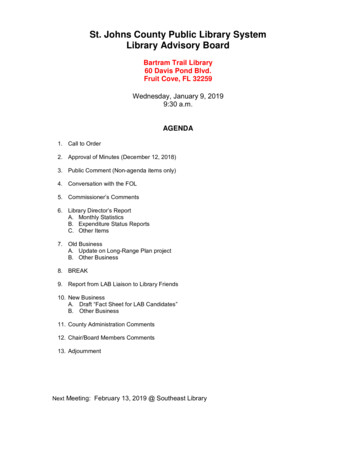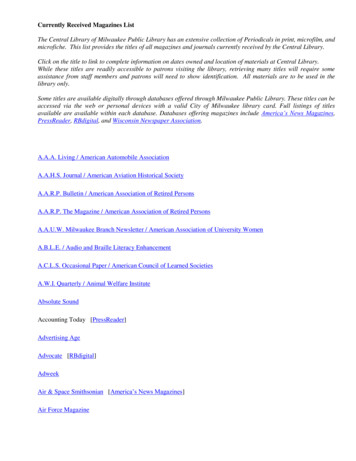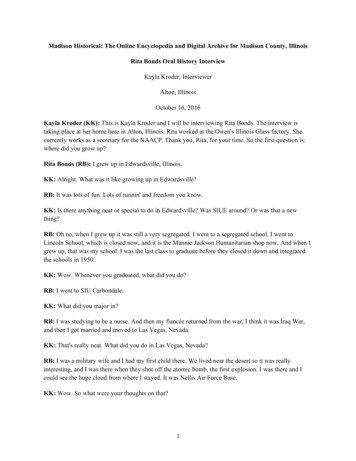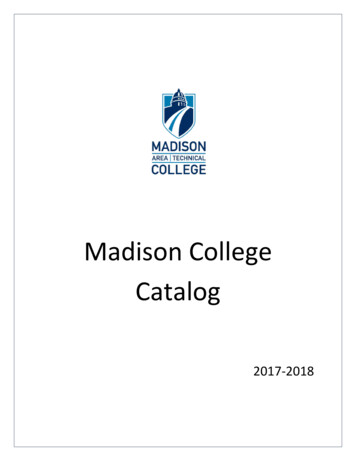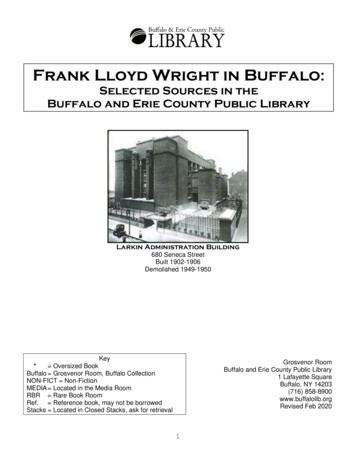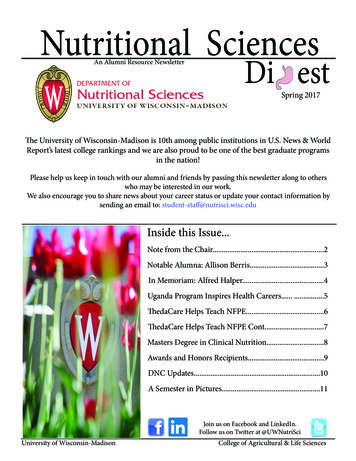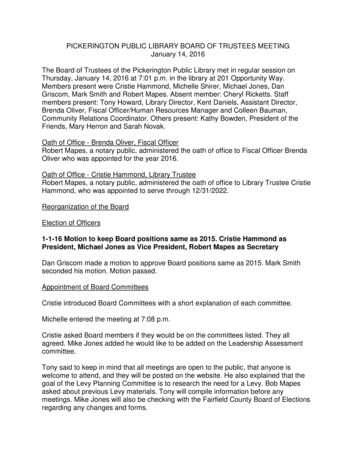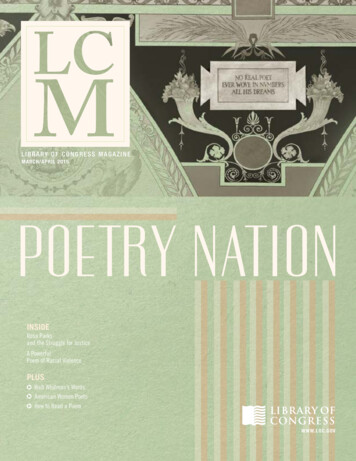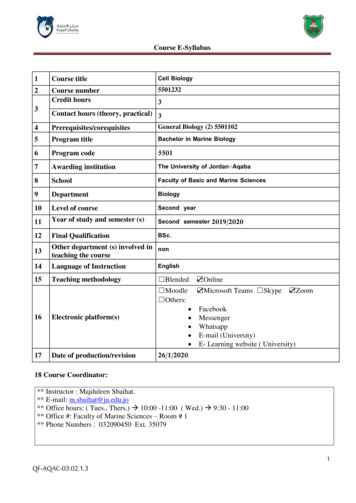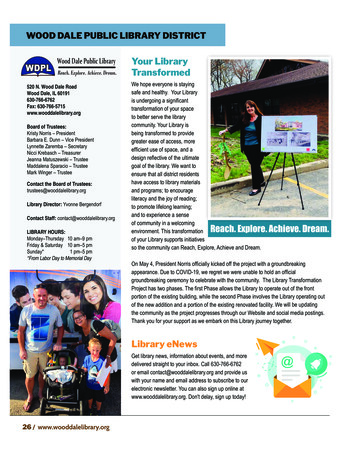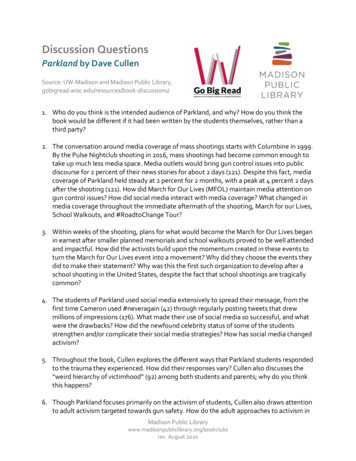
Transcription
Discussion QuestionsParkland by Dave CullenSource: UW-Madison and Madison Public ons/1. Who do you think is the intended audience of Parkland, and why? How do you think thebook would be different if it had been written by the students themselves, rather than athird party?2. The conversation around media coverage of mass shootings starts with Columbine in 1999.By the Pulse Nightclub shooting in 2016, mass shootings had become common enough totake up much less media space. Media outlets would bring gun control issues into publicdiscourse for 2 percent of their news stories for about 2 days (121). Despite this fact, mediacoverage of Parkland held steady at 2 percent for 2 months, with a peak at 4 percent 2 daysafter the shooting (121). How did March for Our Lives (MFOL) maintain media attention ongun control issues? How did social media interact with media coverage? What changed inmedia coverage throughout the immediate aftermath of the shooting, March for our Lives,School Walkouts, and #RoadtoChange Tour?3. Within weeks of the shooting, plans for what would become the March for Our Lives beganin earnest after smaller planned memorials and school walkouts proved to be well attendedand impactful. How did the activists build upon the momentum created in these events toturn the March for Our Lives event into a movement? Why did they choose the events theydid to make their statement? Why was this the first such organization to develop after aschool shooting in the United States, despite the fact that school shootings are tragicallycommon?4. The students of Parkland used social media extensively to spread their message, from thefirst time Cameron used #neveragain (42) through regularly posting tweets that drewmillions of impressions (176). What made their use of social media so successful, and whatwere the drawbacks? How did the newfound celebrity status of some of the studentsstrengthen and/or complicate their social media strategies? How has social media changedactivism?5. Throughout the book, Cullen explores the different ways that Parkland students respondedto the trauma they experienced. How did their responses vary? Cullen also discusses the“weird hierarchy of victimhood” (92) among both students and parents; why do you thinkthis happens?6. Though Parkland focuses primarily on the activism of students, Cullen also draws attentionto adult activism targeted towards gun safety. How do the adult approaches to activism inMadison Public Librarywww.madisonpubliclibrary.org/bookclubsrev. August 2020
the book differ from the way that the Parkland students approach activism? How did theparents support their children’s activism?7. In the aftermath of Parkland, the MFOL students sought stronger gun reform legislation.At the same time, the National Rifle Association (NRA) was influencing legislation toweaken gun laws. Should any lobbying groups have the power to influence legislation tothis extent? To what extent does money play into what actually gets legislated?8. After the shooting, President Trump suggested arming teachers. The NRA supportedTrump, but teachers pushed back, arguing that arming teachers was asking them topotentially kill their own students. How did school safety fit into the MFOL’s gun reformagenda? Why didn’t their agenda focus more on school safety?9. In the Prologue, Cullen notes that “the Parkland kids talk passionately about mental healthwhen asked, but it is not their cause” (11) despite the Parkland shooter’s documentedmental health issues. What role should mental health screening play in the process ofpurchasing guns and assault weapons? Why did the organizers choose to focus their effortson gun legislation instead of mental health? How was their own mental health impacted assurvivors?10. The MFOL movement brought students together both in their activism and in their sharedexperiences with trauma. In healing from this trauma, some students found solace in theiractivism, which, as Dr. Alyse Ley says, serves as a way for students to regain some form ofcontrol over their lives and futures (213). Cullen mentions that activism can also function asa method of avoidance from dealing with fears (93). How did activism contribute to thestudents’ collective healing or avoidance?11. In the Epilogue, Alfonso reflects on his physical state after months of focusing on MFOL,saying “I had gained weight, I didn’t shave for a while or cut my hair, I was wearing thesame clothes. I was slipping in my grades, I had less energy, I slept in way more, workingat the office more than doing homework, I looked like a shell of my former self” (304)Alfonso’s experience is one of many, as the student activists found themselves overworkedfrom devoting so much time to MFOL while still trying to maintain their grades andextracurricular activities. What internal and external factors made it so hard for many of thestudents to find balance? How did burnout affect MFOL as an organization? What neededto change to keep the organization moving forward with their mission?12. The MFOL activists recognized that they were receiving heightened national attentionlargely because they were “privileged white kids” (101). How did they use their privilege tosupport their activism? How did meeting the Peace Warriors impact the MFOL organizersand the scope of the movement?13. Tyah-Amoy Roberts, a Marjorie Stoneman Douglass (MSD) student, confronted DavidHogg on Twitter for his comments about media “not giving black students a voice,” saying,Madison Public Librarywww.madisonpubliclibrary.org/bookclubsrev. August 2020
“This is not the first time you have called out racial disparity, but you have yet to taketangible action to change it with your classmates” (244). Roberts later held a pressconference with other Black MSD students to confront their lack of representation in themedia and the movement. How did this series of events within the course of a week changeMFOL? How did MFOL organizers respond to Roberts’ criticism?14. Despite many being too young to vote, MFOL organizers made voter registration a priorityat every event bearing their name. Just days before their national march, MFOL organizersattended a two-day seminar to learn about “young Americans’ attitudes towards politics”(186). Why did they take the time to attend this seminar, and what did they learn about themotivations of young voters? Why were the organizers focused on young voters?15. With the 2018 elections approaching in a matter of months, MFOL decided to remainbipartisan and focus solely on gun reform and young voter turnout. Why did they choose tobe bipartisan, and what barriers did they face as they worked to remain that way? How didthe election shape the MFOL movement? What lasting impacts did the results of theelection have on the movement and on individual members of MFOL?Madison Public Librarywww.madisonpubliclibrary.org/bookclubsrev. August 2020
About the AuthorSource: davecullen.com/Dave Cullen has been covering the blight of mass murders in America for two decades,first with Columbine, now Parkland: Birth of a Movement. Both were New YorkTimes bestsellers. and Columbine is the consensus definitive account of the horror thatinspired two decades of killers. Parkland takes a fresh approach, focusing on theresponse, and refusing to name the killer. It is story of hope: the genesis of theextraordinary March for Our Lives movement. Dave was with the MFOL students fromthe beginning, with unparalleled access behind the scenes.Columbine made two dozen Best of 2009 lists and won several major awards, includingthe Edgar and Goodreads Choice Awards. It has been translated into six languages,appears on several all-time True Crime Top 10 lists, and Slate named it one of the 50Best Nonfiction Books of the quarter century.Parkland has made ten major year-end Best Lists, been nominated for a GoodreadsChoice Award (Best Nonfiction of 2019), and longlisted for theALA's Andrew Carnegie Medal For Excellence.Dave has written for New York Times, London Times, Vanity Fair, BuzzFeed, Politico,Guardian, Washington Post, New Republic, Newsweek, Daily Beast, Slate, Salon, The Millions,Lapham's Quarterly, etc., and has appeared on most of the major networks in the US, andacross Europe, Asia, Australia and South America.Dave is a former gay army infantry grunt. Parkland struck while he was in year 18 of abook about two gay soldiers. He will finish that soon. Dave wrote Columbine inColorado, then moved to NYC. He is uncle to 11 cool humans and 1 adorablecorgi, Bobby Sneakers.Madison Public Librarywww.madisonpubliclibrary.org/bookclubsrev. August 2020
Book Review:Source: 10/Dave Cullen’s New Book on theParkland Shooting IsSurprisingly IlluminatingWith unrivaled access to the student survivors cum activists, thejournalist brings new perspective to the massacre, one year later.JAKE CLINEFEBRUARY 13, 2019After a gunman murdered 17 students and faculty on February 14, 2018, at Marjory StonemanDouglas High School, Nicole Hockley was urging patience. Hockley had just flown to South Floridafrom California, where, as co-founder and managing director of the anti-gun-violence organizationSandy Hook Promise, she had been working to prevent the type of mass shooting that had justoccurred in Parkland.Hockley met me two days after the shooting, at a bagel shop in Coral Springs. I’d come to interviewher for the South Florida Sun Sentinel, where I worked as an editor and reporter some 11 miles east ofStoneman Douglas. Patience, Hockley told me, would be crucial during the difficult time ahead forthe shooting’s survivors and the victims’ families. Well-wishers and journalists needed to understandthat grief manifests in innumerable ways, and that shared outrage and loss will lead to calls foraction, some immediately, others gradually. Change will come, she insisted, though it likely will be atthe grassroots level, small and incremental. Sandy Hook Promise, after all, spent more than a yearresearching gun violence, school safety, and mental health before implementing its platform.“When the people are really ready to raise their voices and demand things, that’s when you’ll getchange,” said Hockley, whose 6-year-old son, Dylan, was killed in the 2012 shooting in Newtown,Connecticut. “Until then, until people are really engaged, you’re not going to see meaningful changeat [the state and federal] level.”What Hockley didn’t know—what no one did—was that a group of Stoneman Douglas shootingsurvivors was gathering that same day at the home of Cameron Kasky, a gregarious theater kid whowould, like some of the other fed-up teenagers at that meeting, fast become one of the mostMadison Public Librarywww.madisonpubliclibrary.org/bookclubsrev. August 2020
recognizable gun-control activists in the world. The speed at which Kasky and his friends createdtheir movement, alternately known as #NeverAgain and March for Our Lives, and the conditionsthat allowed it to flourish, are the focus of the journalist Dave Cullen’s book Parkland, published thisweek to coincide with the first anniversary of the massacre. It follows January’s Parkland Speaks:Survivors From Marjory Stoneman Douglas Share Their Stories, a heartrending book edited by a ParklandEnglish and journalism teacher, Sarah Lerner, and other works published last year that featureessays, speeches, and reportage by Kasky, David Hogg, Emma González, Delaney Tarr, and otherstudents-turned-household-names.Parkland is the first book about the shooting that’s not marketed toward teens and young adults. Italso may be the most optimistic of the bunch. Cullen is less concerned with recounting the horrorthat took place in the school’s freshman building, and analyzing the institutional and societal failuresthat led to it, than he is in capturing the urgency that propelled the movement from Kasky’s livingroom to voting booths across the country.As Cullen illustrates how the teenagers braved intractable politicians, death threats, and their owntraumas to pursue their mission, Parkland can be an inspiring read. His behind-the-scenes interviewsand interactions with the group’s leaders provide a lot of insight into their strategies andexpectations—he spent 10 months texting and talking with the kids. As a clear sign of the students’trust in him, Cullen was one of the few journalists—in fact, he was one of the few adults—allowedinto the movement’s secret meeting place in “a nondescript strip mall” a short drive from theschool. Here, he found kids being kids.“There was a massive photo of Cameron’s brother Holden in the hallway, nearly floor-to-ceiling,just his head with a huge grin,” Cullen writes. “On a front wall they’d made a photo montage fromsome of the favorite cards they’d received. A big close-up of Emma [González] had beenaccessorized with a curly mustache.” Best of all is the way the teens mockingly posted to a wall nastynotes they’d received via snail mail from a troll who went so far as to include his return address.Cullen obviously connected with the kids, and he movingly relays their confidence that real andlasting change is within reach. If only he had taken more time to tell their story.His previous book, Columbine, a deep and impressive work of investigative journalism, was published10 years after that school shooting. Parkland arrived just 363 days after the Stoneman Douglasmurders. As such, the narrative often feels hurried, and Cullen occasionally succumbs to the firstthey-did-this-and-then-they-did-that method of storytelling. His prose can seem unbridled. (“Thekids were on a wild ride and their parents were buckled in with them.”) And one passage appearstwice in the book: “Young voters have long been a sleeping giant of American politics, because mostof them stay home. If they ever turned out in percentages to match their older counterparts, theycould swing most elections.” Cullen swapped “most elections” for “many elections” in the repeatedsection, but every other word is the same.Still, the author makes a strong case that America, after hitting “rock bottom” following the Pulsenightclub shooting in 2016 and the Las Vegas and Sutherland Springs, Texas, shootings in 2017, wasready for a movement on the scale of March for Our Lives. At the end of the book, he enumeratesMadison Public Librarywww.madisonpubliclibrary.org/bookclubsrev. August 2020
MFOL’s pre- and post-midterm wins, including the formation of nearly 100 chapters around thecountry, the “highest recorded turnout” (31 percent) of voters younger than 30 since 1994, and exitpolls that “showed gun control as voters’ fourth-most-important issue, surpassing any previousresult.” Progress continues beyond the book’s pages: Last week, Congress held its first hearing ongun violence in eight years, and the Giffords Law Center to Prevent Gun Violence issued Florida itsfirst passing grade (C-minus) on the organization’s annual gun-law scorecard, a feat that thecenter credits to “high school activists [who] stepped up and spoke out.”With the election behind them, and with some having graduated from high school or about to,March for Our Lives’ core members have been reevaluating their long-term plans. The kids knowthat to keep saving lives, they must lead lives of their own. They were burned out, and some ofthem, such as Kasky, needed to deal with the depression and anxiety they had tried to suppressduring the campaign season. “I have to apply for college; I have to get a job,” the shooting survivorand activist Alfonso Calderon tells Cullen. Jaclyn Corin, the group’s chief organizer, hopes to seegun violence eradicated by her 30th birthday: “We want [March for Our Lives] to demolish itself soit doesn’t have to exist. It shouldn’t have had to exist ever.”In the epilogue of Parkland, Cullen recalls seeing Springsteen on Broadway on the June night when theBoss broke from his script to praise March for Our Lives. Evidently still floating on the moment,Cullen closes the book with some hopeful, if romanticized, Bruce-like lyricism, an imagining of thekids waking up “weary, bleary” one morning on their cross-country Road to Change tour: “Time tostuff their suitcases, board the Bus to Somewhere, recharge each other with road giggles, and exhalethat hope and wonder into another American town.”And yet, in Florida, where the movement began, hope remains tempered by present realities. OnJanuary 23, a month after Cullen finished editing his book, in a town 150 miles north of Parkland, a21-year-old with a 9 mm handgun walked into a bank and murdered five women. Florida’sRepublican senators and its newly elected, NRA-endorsed governor offered little more than theusual thoughts and prayers. Less than two weeks later, U.S. Representative Matt Gaetz, aconservative Republican from the state’s Panhandle, tried to expel two Stoneman Douglas fathersfrom a congressional hearing on gun violence.The road to change might have gotten shorter in the past year, but even a book as ultimatelyoptimistic as Parkland understands that much asphalt and many obstacles remain.JAKE CLINEis a writer and editor in Miami.Madison Public Librarywww.madisonpubliclibrary.org/bookclubsrev. August 2020
Book Review:Source: ave-cullen.htmlHow the Parkland ShootingLed to a Generation’sPolitical AwakeningBy Hanna RosinFeb. 13, 2019I was in the audience at the March for Our Lives last year when Emma Gonzalez, one ofthe Parkland, Fla., high school students, suddenly fell silent. As the minutes passed, andshe stared us down, her big brown eyes filling with tears, I had the same thoughts asprobably every other protective adult in the crowd: Did she freeze? Forget her lines? Isshe just overcome? Is this poor, brave kid having a public nervous breakdown?What never occurred to me is what Dave Cullen was at that moment chroniclingbackstage for his book “Parkland”: Everything about the moment of silence waschoreographed, the culmination of weeks of planning by the most intrepid group ofteenage survivors ever. These were not a bunch of kids fumbling onstage. Startingwithin hours after the Valentine’s Day shooting, they had begun to assemble into asemiprofessional roving advocacy troupe, focused on moving the needle on gun control.As one survivor, David Hogg, vowed on TV only hours after 17 of his fellow studentswere killed: “I don’t want this to be another mass shooting. I don’t want this just to besomething that people forget.”By the time the rally took place, barely six weeks after the shooting, Emma was used tobeing referred to as “talent,” sitting for countless interviews and profiles notingher shaved head and those big eyes (“intense,” “warm,” “piercing”). She and a handful ofkids from Marjory Stoneman Douglas High School had already faced down MarcoRubio, raised millions from a GoFundMe campaign, beat back hundreds of trolls onTwitter, fielded legal advice from George Clooney and used their youth to try to silencethe N.R.A. and guilt the nation. “We’re children. You guys are the adults,” Hogg said onCNN. “You need to take some action.”Madison Public Librarywww.madisonpubliclibrary.org/bookclubsrev. August 2020
The Parkland survivors emerged at just the right time for Cullen. He wrote the book“Columbine,” a deeply researched and thorough account of the 1999 massacre at aColorado school that ushered in the era of school shootings. Years of covering shootings,being called as an expert talking head on shootings, writing and thinking aboutshootings have left Cullen with a diagnosis of “vicarious traumatization,” he writes, andtwice in the last seven years he’s found himself sobbing and immobilized for days.Although he doesn’t say it explicitly, following the Parkland kids seems like a form oftherapy for Cullen himself, and, he hopes, the nation. “There were no vacant stares fromthe Parkland survivors,” he writes. “This generation had grown up on lockdown drills —and this time, they were ready.”With “Parkland,” Cullen aims for a straightforward inspirational story of a group of kids“healing each other as they fought.” They knew one another from drama club, andinstinctively understood how to position themselves on a national stage. At a candlelightvigil, one of them introduced herself to the Florida congresswoman Debbie WassermanSchultz, who connected her to a state senator, who helped the kids figure out how to getfloor time at the statehouse. Another came up with #NeverAgain while he was on thetoilet in his pajamas. The hashtag went viral and landed him on “Anderson Cooper 360”and NPR. Basically every time Emma Gonzalez opened her mouth, she went viral. Andwithin a couple of weeks they had ambitions of planning a rally as big as the Women’sMarch.How or why these particular kids came to be so rapidly effective is not exactly clear fromthe book. Cullen partly chalks it up to generational wisdom. They understood newscycles and Twitter, viral videos and memes, and they set out to make themselves asrelevant as possible. They understood they would be perceived as privileged white kidswho live in gated communities, so they made alliances with groups that focus on urbanschool violence and shared the stage with them. They understood that no politicianwants to be seen dismissing a kid who just saw his or her friends shot, so they staged asmany showdowns as possible. In retrospect it seems extraordinary that all the piecescame together so effortlessly, yet even after reading the book I’m not exactly sure whythis group of kids, at this particular moment.In “Columbine,” Cullen punctured the lazy media narrative that the shooters, EricHarris and Dylan Klebold, were goth vigilantes, crusaders against bullies and meangirls. They were, he concluded, a psychopath and a depressive, and should be viewedthrough the lens of mental illness, and not school cliques and revenge — a point he’srepeated about many school shooters since. And partly thanks to Cullen, the rules ofcovering shootings have shifted. It’s become something of a taboo to spend too muchenergy on the psyche of the shooters, and definitely a taboo to glamorize their motives inany way.Madison Public Librarywww.madisonpubliclibrary.org/bookclubsrev. August 2020
In his new book, Cullen spends barely three pages on the Parkland gunman, giving justthe barest biographical details, mostly about his depression, and referring to him only asthe “mass murderer.” It’s a noble goal, to refuse to feed our fascination with thederanged teenage killer or provide the convenient horror movie plot. May everyjournalist follow his example so fewer mentally ill teenagers get the idea that shootingup their school will make them famous. But that commitment also presents a separatenarrative challenge, which is how to create a story with drama and tension.Cullen spent the 11 months after the shooting following the kids, which is enough timeto plot the stages of their crusade but not necessarily enough to understand theirinternal struggles. He hints at possible tensions: parents worrying whether theirsuddenly energized kids were just suppressing trauma, kids getting used to their suddenfame, kids getting hammered by internet trolls, facing death threats, losing their friendswho were jealous that now they had thousands of followers on Twitter. He mentions amother who went to a support group and was chided because her son wasn’t at school atthe time of the shooting — part of what Cullen refers to as the “weird hierarchy ofvictimhood.” But Cullen breezes by these moments and quickly returns to the ticktock oforganizing the big rally.Maybe it’s unfair to place even more burden on this group of teenagers to become ourperfect heroes. After all, at the time they were facing down congressmen, they were stillnot old enough to vote. But I did find myself wishing for some more depth, detail orpsychological complexity, something to cement these extraordinary kids in the publicimagination so that we’d never forget what they somehow managed to pull off.Hanna Rosin, a co-host of the NPR show “Invisibilia,” is the author of “The End of Men.”A version of this article appears in print on March 10, 2019, Page 14 of the Sunday BookReview with the headline: Shots Fired.Madison Public Librarywww.madisonpubliclibrary.org/bookclubsrev. August 2020
Book Review:Source: e-cullen-reviewParkland by Dave Cullen review– the shooting that led to changeFor once the survivors became more famous than the shooter . A hopeful study ofMarch for our Lives from the author of ColumbineLois BeckettFri 1 Mar 2019 04.00 ESTTwenty years ago, Dave Cullen was a freelance journalist who responded to reports ofshots fired at Columbine high school. He drove towards a ring of helicopters hoveringover suburban Colorado. The carnage he found there – 13 people dead, more than 20injured – was hard to fathom. So was the reaction of the student survivors: the day afterthe shooting, they were numb, emotions muted. What was happening, the teenagersasked him. Would they get better?Cullen spent the next decade investigating why two students had opened fire on theirclassmates, and what exactly had happened. His first book, Columbine, published in2009, would become the definitive account, one that pushed back against manypersistent Columbine myths, including a belief that high school outcasts had carried outthe attack as revenge against the jocks who had bullied them.Cullen’s reporting made him the go-to expert on US mass violence. It also left him withpost-traumatic stress. He eventually learned to set boundaries, promising his therapistthat he would be careful with his coverage of mass shootings. It was not the storiesabout the perpetrators that left him shaken – he could follow those with professionaldistance – but the coverage of survivors.The 14 February 2018 shooting at a high school in Parkland, Florida, which left 17students and teachers dead, changed all that. For the first time, teenage survivors ofsuch an atrocity reacted with fury. They demanded immediate government action andassailed adults for failing to protect them. The kids did not worry about “politicising” atragedy: their friends’ murder, they argued, was already political. “They say tougherMadison Public Librarywww.madisonpubliclibrary.org/bookclubsrev. August 2020
guns laws do not decrease gun violence. We call BS,” 18-year-old Emma González said ina speech, three days after the shooting, that went viral.Drawn by the promise of real change, Cullen flew to Florida. Throughout the spring, asAmerican teenagers staged waves of walkout protests at high schools across the country,he followed the Parkland students whose outrage had sparked a national move-ment.He reported from the tiny office they set up in a Florida shopping mall, where currentstudents and a few recent graduates workshopped the memes they would use in socialmedia warfare with the National Rifle Association, and documented their early protests.He saw how they were shaken by the counter-protesters who showed up at their eventsarmed with guns.Parkland focuses purely on the March for Our Lives movement, from the founders’ firstdays organising in one student’s living room, to a rally for gun control that drewhundreds of thousands of people to Washington and more than a million across thecountry, to their campaign to turn out young voters in the 2018 midterm elections. Thebook does not delve into the details of the attack at the school, the red flags lawenforcement missed, or the partisan local debates over who was most to blame. It doesnot even mention the shooter’s name. After 20 years of chronicling violence and failure,Cullen wants to tell a story of hope.Unlike Columbine, his new book does not challenge the accepted narrative of theshooting or its aftermath. He believes the Parkland students achieved real change andare on their way to even greater victories. But he does not gloss over what was messyand painful about the movement’s growth. He shows the simmering tension within theParkland student body over how the media reaction to the shooting made just a handfulof them internationally famous. The students who had spoken out most powerfully werenot the ones in the freshman building during the attack. They were not the ones whohad been injured, or who had just watched their friends get shot. The resentments andjealousies over who had been chosen to speak for the school would not go away. One ofthe students who appeared on the cover of Time tells Cullen she has lost many of herfriends.Cullen discusses the criticism the March for Our Lives founders received for notincluding any black Parkland students in their initial organising, and how the groupwould later publicly denounce the longstanding racism of the gun debate, which foryears has placed more attention on the rare killings of suburban white children than theeveryday deaths of young people of colour.Cullen describes the uncertainty a youngactivist from Chicago felt as he arrived at the wealthy gated community in Parkland for ajoint meeting about youth gun violence activism. What would it look like to worktogether? The meeting with Chicago activists would mark a turning point towards aMadison Public Librarywww.madisonpubliclibrary.org/bookclubsrev. August 2020
more inclusive, national movement. It also provided a key strategic intervention at amoment when the Parkland students were facing increased public abuse, and werestruggling to find the right tone to respond. D’Angelo McDade, part of Chicago’s PeaceWarrior group, taught the Parkland students Martin Luther King Jr’s six principles ofnon-violence. Principle three, “non-violence seeks to defeat injustice, not people”,Cullen writes, would prove influential in shaping the students’ political response to theircri
first with Columbine, now Parkland : Birth of a Movement. Both were New York Times bestsellers. and Columbine is the consensus definitive account of the horror that inspired two decades of killers. Parkland takes a fresh approach, focusing on the response, and refusing to
